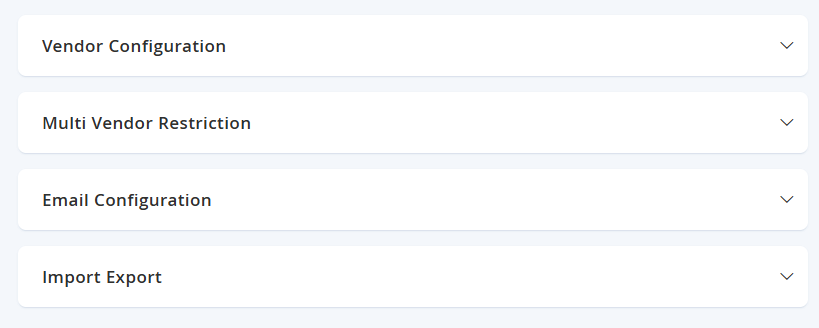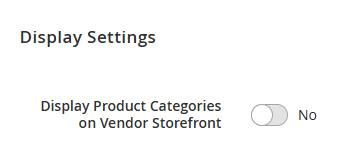Vendor Settings
This can be found from the Vendor menu item of the Omnyfy Configurations.

There are a lot of configurations available, however we will cover the main settings for now. The other fields can remain as default.
Vendor Configuration
Field Name | Notes | Scope |
|---|---|---|
Products to Multiple Vendors | Determines if the same product can be assigned to multiple vendors on the marketplace - however this is currently deprecated. Please ignore this. | Global |
Invoice By | Allows the marketplace owner to choose if the invoice to the customer is by Vendor or by the Marketplace Owner. Default setting is by Vendor. This sets the email to a split order email where each item is grouped by the Vendor from which the item was purchased and the Vendor's Tax Information is also displayed on the invoice. If set to Marketplace Owner, the customer will receive a consolidated invoice with the tax information being the Marketplace Owner's tax information. | Global |
Email Invoice Attachment | Enable sending of individual Vendor Invoices to Customer. Only applicable if Invoice By is set to Vendor. | Global |
Shipment By | Dictates if the shipments will be managed by Vendors or the Marketplace Owner. | Global |
Tax Number of Marketplace Owner | Dictates the tax number used when sending invoices | Global |
Calculate Shipping By | Set to Per Vendor if using Shipping Methods that support Per Vendor calculations where each vendor ships their own order items individually. Only set to Overall Cart if the Marketplace uses centralised shipping such as for Shopping Centres where there is a single point of origin for all products. | Global |
Checkout shipping message enabled | This allows you to display a message (entered in Checkout shipping message content) at checkout above the Shipping Prices. This does not apply to Glyde controlled websites. | Store View |
Checkout shipping message content | The content that you wish to display in checkout, above the Shipping Prices. Only appears if the Checkout shipping message enabled is set to Yes. | Store View |
Display Product Categories on Vendor Storefront | Allows Product Categories (that vendors are selling) in to appear on the Vendor Page. This will only appear if the Category configuration is set to display the products - see Catalog > Categories > Selected Category > Display Settings > Display Product Categories on Vendor Storefront.
This does not apply to Glyde controlled websites. | Store View |
Order Webhook Endpoint | This endpoint can be used to push order data when a new order is placed or status is changed. Generally used for shipping solutions that return Webhooks to update orders. Not required otherwise. | Global |
Complete Order Webhook Endpoint | This endpoint can be used to push order data when an order is complete. Generally used for shipping solutions that return Webhooks to update orders. Not required otherwise. | Global |
Support Link | Allows a small question mark icon to appear at the top right of the Admin Portal, that can redirect users to a help page (this will open a new tab). Insert the link here.
| Global |
Vendor Can Create Customer | Allows Vendors the capability of adding a new customer from the Admin Portal. By default, this is set to No. | Store View |
Multi Vendor Restriction
This allows you to set if you wish to restrict Customers from being able to add/purchase products from multiple vendors at the same order.
| Field Name | Notes | Scope |
|---|---|---|
| Enabled | Set this to Yes to only allow products from one vendor at a time to be added to the Shopping Cart. | Website |
| Confirmation Message | This message will appear if a Customer attempts to add a product from another vendor, if they already have products in their shopping cart from a different vendor. | Store View |
Email Configuration
| Field Name | Notes | Scope |
|---|---|---|
| Send Vendor Order Confirmation when Order Status is... | Allows you to set the Order Status, in which Vendors will receive Order Confirmation emails from. This will generally depend on your payment method and business flow. The default is generally when an order is put in Processing Status. | Store View |
| Email Sent From | Set which email address the notifications to the vendor (from the marketplace) come from. You must have already set up the Store Email Addresses for this to apply. See Stores > Settings > Configuration > General > Store Email Addresses. | Store View |
| Vendor order notification template | Sets which e-mail template is used when sending order notifications to vendors. You can leave this as Default, unless you have a custom template for this. See Marketing > Communications > Email Templates. | Store View |
Import Export
| Field Name | Notes | Scope |
|---|---|---|
| Export mode | Here you can set this to Asynchronous or Synchronous. | Global |
Select Save Config from the top right when configuration is complete.
Updated 7 months ago


